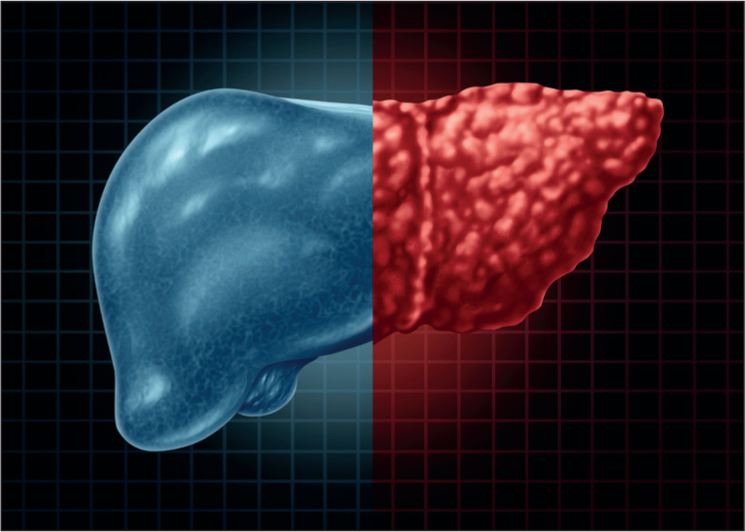Global prevalence of non-alcoholic fatty liver disease in type 2 diabetes mellitus

Non-alcoholic fatty liver disease (NAFLD) is the leading cause of chronic liver disease, with type 2 diabetes (T2D) a major predictor, and NAFLD can range from simple steatosis (non-alcoholic fatty liver) to the more advanced form non-alcoholic steatohepatitis (NASH).
This is cited by Cho et al (2023) who undertook a meta-analysis to review and quantify the prevalence of NAFLD and NASH among those with T2D and to evaluate the prevalence of clinically significant and advanced fibrosis in NAFLD and NASH in the T2D population. They considered 156 studies, and a pooled analysis of 1,832,125 patients found that the prevalence rates of NAFLD and NASH in T2D were 65.04% and 31.55%, respectively.
The authors found that the prevalence rates of NAFLD in primary healthcare populations compared to hospital-based cohorts were 61% and 66%, respectively: ‘The high prevalence, regardless of setting, is concerning and supports the recommendations for screening, early detection, and treatment to reduce the burden of NAFLD–T2D.’ The American Diabetes Association currently recommends that all patients with T2D and pre-diabetes are screened for NAFLD. The authors conclude that with a higher risk of advanced fibrosis in NAFLD–T2D, early intervention and prevention are needed to reduce the global burden of NAFLD and NASH.
Heart failure and socioeconomic status: global differences and inequalities
The Global Congestive Heart Failure (G-CHF) registry is a multinational registry of patients with a diagnosis of heart failure (HF) enrolled at 257 centres from 40 countries across 5 continents. Vergallo and Patrono (2023) comment on a study that analysed differences in HF among countries with different levels of economic development.
HF was categorized as due to ischaemic heart disease (IHD), hypertension, rheumatic valve disease, non-rheumatic valve disease, and idiopathic or other causes. According to left ventricular ejection fraction (LVEF) measured on echocardiogram, patients were classified as having HF with reduced ejection fraction (HFrEF, EF ≤ 40%), mildly reduced ejection fraction (HFmrEF, EF 41%–49%), or preserved ejection fraction (HFpEF, EF ≥ 50%).
Between 2016 and 2020, 23,341 patients (mean age, 63 years; 39% female) were enrolled on the G-CHF registry. The median follow-up duration was 2 years, with 68% of participants recruited as outpatients and the remainder as inpatients. Most patients (61%) had a diagnosis of HFrEF, and a minority had a diagnosis of HFmrEF (15%) or HFpEF (24%).
The HF aetiology reported most often was IHD (38%), followed by hypertension (20%) and idiopathic dilated cardiomyopathy (15%). Hypertension was reported most often in low-income countries, while IHD was reported most often in higher-income countries.
Symptoms of insomnia and pain with osteoarthritis
Osteoarthritis (OA) is the most common type of chronic arthritis, with knee and hip joints often affected. Yet treatment outcomes of behavioural pain management and exercise therapy on OA-related pain, physical function and quality of life are modest, possibly because coexisting conditions or symptoms are typically neglected because of a focus on joint pain and pain-related disability. This is particularly true for symptoms of insomnia.
In this review, De Baets et al (2023) consider the relationship between insomnia symptoms and OA-related pain among those with OA. It appears that depressive symptoms, pain catastrophizing and pain self-efficacy may partly explain the cross-sectional association between insomnia symptoms and pain among those with OA. Further, compared to treatments without a specific insomnia intervention, those that do include an insomnia intervention appear more effective for improving insomnia symptoms, although not for reducing OA-related painIn the screening of people with osteoarthritis, symptoms of insomnia should be considered: ‘More specifically, information regarding sleep quality and quantity, onset and triggers of sleeping problems, sleeping habits, thoughts and cognitions about sleep, coping behaviours and treatment history can be gathered.’ The authors further suggest that randomised controlled trials are needed that investigate the effectiveness of a combined insomnia and OA management on insomnia symptoms and clinical OA-related pain.

Parental occupational exposure to metals and risk of cancer
Carcinogenic metals like arsenic, cadmium and nickel are potent mutagens and are widespread in some workplaces such as metal industries, smelters, and electronics manufacturers. It is unclear, however, whether parental occupational exposure confers higher risks of cancer in offspring. Rossides et al (2023) used Swedish registers and a nationally developed job-exposure matrix, to estimate relative risks of childhood cancer, overall and by type, associated with maternal or paternal occupational exposure to arsenic, cadmium, chromium, iron, nickel, and lead around the time of a child's conception and birth.
For maternal exposures, analyses included 9,653 cancer cases and 172,194 matched controls. For paternal exposures, analyses included 12,521 cancer cases and 274,434 matched controls. The results showed that maternal exposure to arsenic was associated with a 38% higher risk of cancer in the offspring of these women, and although some weaker associations for chromium, iron, and nickel were observed they were imprecise.
In relation to paternal exposure, the authors did not observe any associations between paternal exposure to any of the metals and cancer in the offspring, either overall or by cancer type, child sex, or in sensitivity analyses. The authors state that if their ‘findings are corroborated by other studies, they indicate that mothers and offspring are particularly vulnerable to these heavy metals and should be better protected against these hazards at the workplace.’


